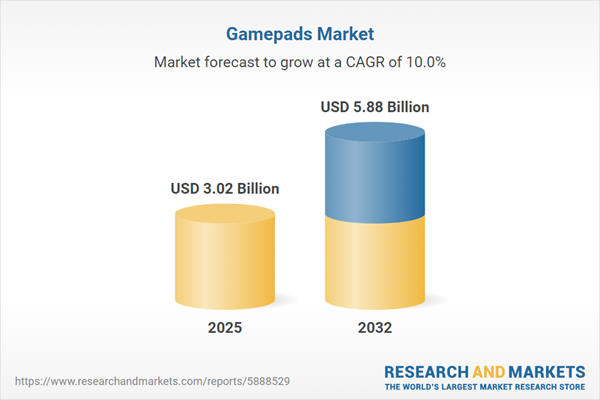Speak directly to the analyst to clarify any post sales queries you may have.
The gamepad market is rapidly advancing, propelled by technology breakthroughs, changing player behaviors, and increasing demands across gaming environments. Senior decision-makers seeking actionable intelligence on controllers will find valuable insights into the forces shaping innovation, supply chains, and competitive strategies.
Market Snapshot: Growth Outlook for the Gamepads Market
The Gamepads Market grew from USD 2.74 billion in 2024 to USD 3.02 billion in 2025. It is expected to continue growing at a CAGR of 9.99%, reaching USD 5.88 billion by 2032.
Scope & Segmentation of the Gamepads Market
This report provides a comprehensive analysis across technology shifts, player interaction models, and ecosystem opportunities. It covers the following main segmentation criteria:
- Connectivity: Wired (USB), Wireless (Bluetooth, RF)
- Application: Console (Nintendo, PlayStation, Xbox), Mobile (Android, iOS), PC (Linux, Mac, Windows)
- Distribution Channel: Offline (Hypermarket, Specialty Store), Online (Brand Website, E-Commerce Platform)
- End User: Commercial (Arcade, Esports Venue), Home
- Price Range: Economy, Mid Range, Premium
- Platform Compatibility: Cross Platform, Single Platform
- Geographic Regions: Americas (North America, Latin America), Europe, Middle East & Africa, Asia-Pacific (China, India, Japan, and additional key markets)
Leading technology segments include modular architectures, adaptive triggers, advanced haptics, and low-latency wireless protocols. Comprehensive geographic coverage highlights the diverse market trajectories across mature and emerging economies.
Key Takeaways: Strategic Insights and Trends
- Ergonomics and adaptive materials research continue to transform controllers into extensions of player intent, raising expectations for comfort and fatigue reduction.
- Growth of esports and cloud gaming is intensifying the need for low-latency, high-precision devices compatible across multiple ecosystems.
- Demand for customization and modularity enables users to personalize hardware for unique playstyles and device integrations, strengthening brand loyalty.
- Third-party manufacturers benefit from increasing interoperability standards, opening new avenues for differentiation through firmware and open-source protocols.
- Shifts in distribution—from traditional retail to digital direct-to-consumer channels—are creating new competitive pressures and opportunities for agile market entrants.
Tariff Impact on Supply Chain Strategies
The introduction of United States tariffs on select electronic components in 2025 is affecting sourcing and production strategies. Manufacturers are revising supply chains, reallocating assembly operations, and negotiating supplier concessions to mitigate rising costs. Regionalized production and investment in automation support resilience amid evolving trade policies.
Methodology & Data Sources
Research integrates primary interviews with product managers, engineers, and executives, supplemented by end-user surveys. Secondary data includes industry reports, regulatory filings, and company financial disclosures. Insights are validated using triangulation with external expert reviews and independent third-party sources to ensure market accuracy.
Why This Report Matters: Value for Senior Decision-Makers
- Helps executives identify emerging growth opportunities, optimize supply chains, and target R&D investments aligned with evolving demand.
- Offers granular segmentation and actionable competitive analysis to guide product portfolio decisions and partnership strategies in complex global markets.
- Supports the development of region- and segment-specific go-to-market tactics based on differentiated customer needs and regulatory landscapes.
Conclusion: Navigating the Evolving Gamepads Market
Senior leaders equipped with data-driven insights from this report can adapt swiftly to disruptive trends and policy changes. Informed strategic decisions will enable companies to strengthen competitiveness and capture value in the fast-evolving gamepad sector.
Additional Product Information:
- Purchase of this report includes 1 year online access with quarterly updates.
- This report can be updated on request. Please contact our Customer Experience team using the Ask a Question widget on our website.
Table of Contents
3. Executive Summary
4. Market Overview
7. Cumulative Impact of Artificial Intelligence 2025
Companies Mentioned
The companies profiled in this Gamepads market report include:- Sony Interactive Entertainment LLC
- Microsoft Corporation
- Nintendo Co., Ltd.
- Logitech International S.A.
- Razer Inc.
- Turtle Beach Corporation
- Guillemot Corporation S.A.
- HORI Co., Ltd.
- Performance Designed Products, Inc.
- 8BitDo Inc.
Table Information
| Report Attribute | Details |
|---|---|
| No. of Pages | 181 |
| Published | October 2025 |
| Forecast Period | 2025 - 2032 |
| Estimated Market Value ( USD | $ 3.02 Billion |
| Forecasted Market Value ( USD | $ 5.88 Billion |
| Compound Annual Growth Rate | 9.9% |
| Regions Covered | Global |
| No. of Companies Mentioned | 11 |









